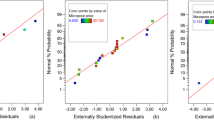Summary
Surface modification of HDPE powders by oxygen plasma has been carried out in a circulating fluidized bed (CFB) reactor. The effects of solid holdup, treatment time and radio frequency (rf) power of oxygen plasma on the surface composition and hydrophilicity of HDPE powders have been determined. The solid holdup in the plasma reaction zone mainly governs the stability of plasma glow and surface property of the powders. The hydrophobic surface can be transformed to hydrophilic of HDPE powder and the oxygen functionalities are formed including C=O and C(O)O-, which reach 12% and 8% respectively of the total carbon elements by the oxygen plasma treatment. The CFB reactor outperforms 3.4 times to obtain the similar level of hydrophilicity compared to that in a bubbling fluidized bed based on the composite parameter [(W/FM)t]. The present CFB reactor can be utilized to modify the polymeric surface from hydrophobic to hydrophilic with high-energy efficiency.
Similar content being viewed by others
Author information
Authors and Affiliations
Additional information
Received: 21 June 2001/Revised version: 10 August 2001/Accepted: 20 August 2001
Rights and permissions
About this article
Cite this article
Jung, S., Park, S., Lee, D. et al. Surface modification of HDPE powders by oxygen plasma in a circulating fluidized bed reactor. Polymer Bulletin 47, 199–205 (2001). https://doi.org/10.1007/s002890170012
Issue Date:
DOI: https://doi.org/10.1007/s002890170012




